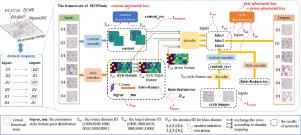Medical Image Analysis ( IF 10.9 ) Pub Date : 2022-06-23 , DOI: 10.1016/j.media.2022.102520 Ranran Zhang 1 , Yankun Cao 2 , Yujun Li 1 , Zhi Liu 1 , Jianye Wang 3 , Jiahuan He 3 , Chenyang Zhang 3 , Xiaoyu Sui 1 , Pengfei Zhang 4 , Lizhen Cui 2 , Shuo Li 5

|
To the best of our knowledge, artificial intelligence stain generation is an urgent requirement for histopathology images. Pathological examinations usually only utilize hematoxylin and eosin (H&E) regular staining to show histomorphological characteristics, but to accurately diagnose the disease, functional staining (such as oil red O and Ki67) are also required to provide important auxiliary information. However, the same tissue section is usually stained with one stain, and additional functional staining is not only time-consuming but also causes inevitable morphological misalignment due to manual manipulation. This brings difficulties to the development of artificial intelligence pathological image analysis tools. In this work, we propose a histopathology staining transfer framework to generate virtual functional staining images from H&E regular staining images. Compared with the framework that emphasizes generation diversity in the natural image field, we use KL loss and histo loss to align and separate style feature spaces in different domains to obtain domain-variant style features. The proposed multiple virtual functional stain (MVFStain) abstracts staining conversion to domain mapping and comprehensively utilizes multiple staining information. We evaluated the proposed method on four datasets (lung lesion, lung lobes, breast, and atherosclerotic lesion). The experiment involves the translation of H&E to nine other functional stains: CC10, Ki67, proSPC, HER2, PR, ER, oil red O, -SMA, and macrophages. The major quantitative results are divided into image quality and positive signal prediction. MVFStain is close to or even surpasses one-to-one image translation on psnr and HTI image quality metrics. The best psnr reaches 26.1919, and HIT reaches 0.9430. We used mIOD to evaluate the optical density of positive signals, and CNR and gCNR to evaluate the lesion detectability. The results show that the mIOD of positive signals of virtual staining was slightly lower than the ground truth and close the lesion detectability of artificial staining. These results prove that the potential exists to develop a successful clinical alternative to artificial functional stains.
中文翻译:

MVFStain:基于特定域映射的多个虚拟功能染色组织病理学图像生成
据我们所知,人工智能染色生成是组织病理学图像的迫切要求。病理检查通常仅利用苏木精和伊红(H&E)常规染色来显示组织形态学特征,但要准确诊断疾病,还需要功能性染色(如油红O和Ki67)提供重要的辅助信息。然而,同一组织切片通常只用一种染色剂染色,额外的功能染色不仅耗时,而且由于手动操作导致不可避免的形态错位。这给人工智能病理图像分析工具的开发带来了困难。在这项工作中,我们提出了一个组织病理学染色转移框架,以从 H& 生成虚拟功能染色图像。E 常规染色图像。与在自然图像领域强调生成多样性的框架相比,我们使用 KL loss 和 histo loss 来对齐和分离不同域的样式特征空间,以获得域变的样式特征。提出的多重虚拟功能染色(MVFStain)将染色转换抽象为域映射,并综合利用多种染色信息。我们在四个数据集(肺病变、肺叶、乳房和动脉粥样硬化病变)上评估了所提出的方法。该实验涉及将 H&E 翻译成其他九种功能性染色剂:CC10、Ki67、proSPC、HER2、PR、ER、油红 O、我们使用 KL 损失和 histo 损失来对齐和分离不同域中的样式特征空间,以获得不同域的样式特征。提出的多重虚拟功能染色(MVFStain)将染色转换抽象为域映射,并综合利用多种染色信息。我们在四个数据集(肺病变、肺叶、乳房和动脉粥样硬化病变)上评估了所提出的方法。该实验涉及将 H&E 翻译成其他九种功能性染色剂:CC10、Ki67、proSPC、HER2、PR、ER、油红 O、我们使用 KL 损失和 histo 损失来对齐和分离不同域中的样式特征空间,以获得不同域的样式特征。提出的多重虚拟功能染色(MVFStain)将染色转换抽象为域映射,并综合利用多种染色信息。我们在四个数据集(肺病变、肺叶、乳房和动脉粥样硬化病变)上评估了所提出的方法。该实验涉及将 H&E 翻译成其他九种功能性染色剂:CC10、Ki67、proSPC、HER2、PR、ER、油红 O、和动脉粥样硬化病变)。该实验涉及将 H&E 翻译成其他九种功能性染色剂:CC10、Ki67、proSPC、HER2、PR、ER、油红 O、和动脉粥样硬化病变)。该实验涉及将 H&E 翻译成其他九种功能性染色剂:CC10、Ki67、proSPC、HER2、PR、ER、油红 O、-SMA 和巨噬细胞。主要的定量结果分为图像质量和正信号预测。MVFStain 在 psnr 和 HTI 图像质量指标上接近甚至超过一对一图像转换。最佳 psnr 达到 26.1919,HIT 达到 0.9430。我们使用 mIOD 评估阳性信号的光密度,使用 CNR 和 gCNR 评估病变可检测性。结果表明,虚拟染色阳性信号的mIOD略低于ground truth,接近人工染色的病灶可检测性。这些结果证明存在开发人工功能性染色剂的成功临床替代品的潜力。


























 京公网安备 11010802027423号
京公网安备 11010802027423号